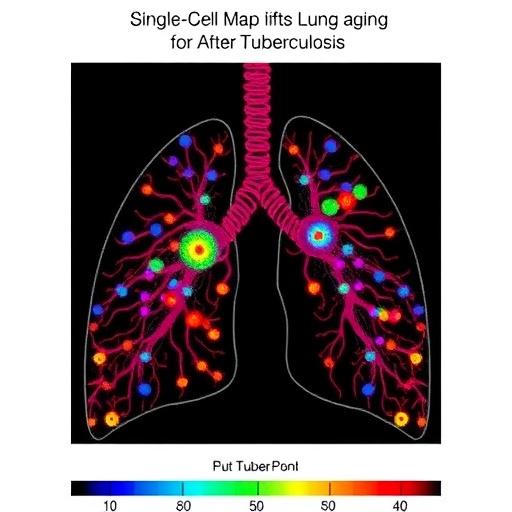
In the wake of successful tuberculosis (TB) treatment, a perplexing clinical challenge emerges: a subset of patients experience relentless and progressive lung damage that severely impairs respiratory function. Despite globally concerted efforts to combat Mycobacterium tuberculosis infection, the scars it leaves behind have long been shrouded in mystery, hampering effective strategies to repair or reverse the destruction. Now, an ambitious research endeavor employing cutting-edge single-cell transcriptomic technology shines a powerful light on the cellular undercurrents that drive this post-tuberculosis pulmonary deterioration.
The study, conducted by Sun, Li, Ping and their colleagues, delves into the landscapes of human lung tissue recovered from individuals with a history of TB. By scrutinizing 19 post-tuberculosis lung samples along with 13 matched normal lung tissues used as controls, they journey beyond conventional bulk analysis towards an intricate, cell-by-cell exploration. Their approach zeroes in on the microenvironments within and immediately surrounding residual tuberculosis lesions, aiming to decode the molecular footprints that linger after the bacteria’s defeat.
Among the striking revelations of this investigation is the identification of a consistent molecular signature echoing across multiple lung cell populations. This signature weaves a complex tapestry of cellular senescence, chronic inflammation, progressive fibrosis, and apoptotic signaling—processes that collectively choreograph the decline of lung architecture and function. Notably, this study uncovers an elevation in vascular inflammation as a pivotal hallmark of post-tuberculosis lung pathology, suggesting that the blood vessel lining cells play a critical role in the long-term damage.
.adsslot_1AJKIEej5n{width:728px !important;height:90px !important;}
@media(max-width:1199px){ .adsslot_1AJKIEej5n{width:468px !important;height:60px !important;}
}
@media(max-width:767px){ .adsslot_1AJKIEej5n{width:320px !important;height:50px !important;}
}
ADVERTISEMENT
Dissecting the transcriptional profiles reveals a coordinated suppression of FOXO3 signaling pathways alongside amplification of NF-κB-driven thromboinflammatory responses. FOXO3, a transcription factor broadly implicated in longevity and cellular stress resistance, emerges here as a guardian diminished in its protective capacity. Conversely, activation of NF-κB, a notorious regulator of inflammatory gene networks, fuels a prothrombotic and inflammatory milieu that likely perpetuates tissue injury long after the initial infection subsides.
The investigators validate these transcriptomic observations through functional assays that manipulate the endothelial cells lining pulmonary blood vessels. By silencing FOXO3 via small interfering RNA and administering thrombin—a key coagulation protein—they experimentally recapitulate enhanced cellular senescence and inflammatory responses. This experimental validation underscores the mechanistic axis linking reduced FOXO3 activity and thrombin-driven NF-κB activation to ongoing endothelial dysfunction and tissue degeneration.
Such endothelial dysfunction and vascular inflammation have profound implications for lung health. The fine capillary networks essential for gas exchange appear compromised, setting the stage for hypoxia, impaired tissue repair, and relentless fibrotic remodeling. Senescent endothelial cells adopt a pro-inflammatory secretory phenotype that further recruits immune cells and amplifies local damage, creating a vicious cycle of persistent injury.
The impact of chronic inflammation and fibrogenesis following tuberculosis extends beyond localized tissue destruction. Distorted lung mechanics and stiffened extracellular matrices impair respiratory compliance, often explaining why patients continue to suffer breathlessness, cough, and diminished quality of life despite microbiological cure. This study’s insights into the molecular drivers of these changes offer promising avenues for precision therapies aimed at halting or even reversing lung impairment after TB.
By charting the single-cell transcriptomic atlas of the post-tuberculosis lung, this work provides an unprecedented resolution into the heterogeneous cellular ecosystem affected by TB. It highlights not merely the immune cells but also structural and endothelial cells as active participants in disease perpetuation. The complex interplay between senescence signaling, inflammatory cascades, and vascular pathology emerges as a central theme warranting further clinical exploration.
Moreover, the findings challenge the traditional focus on antibacterial treatment as the sole solution for tuberculosis morbidity. They spotlight the necessity of targeting the host tissue responses that outlive the pathogen, particularly those that orchestrate irreversible tissue damage. Efforts to modulate FOXO3 signaling or interrupt thromboinflammation could form the basis of adjunctive therapies designed to restore lung function and prevent progression to chronic respiratory failure.
The repercussions extend to global health landscapes where tuberculosis remains endemic. Millions survive TB each year, yet many face long-term disability attributable to lung sequelae. Understanding and intervening in the molecular cascades identified here could improve patient outcomes, reduce the burden on healthcare systems, and elevate quality of life for TB survivors worldwide.
This research also exemplifies the power of single-cell transcriptomics as an investigative tool in infectious disease sequelae, revealing nuances that bulk tissue analyses cannot resolve. By mapping gene expression profiles at cellular resolution, scientists can unravel complex pathologies and identify precise cellular targets with therapeutic potential.
The complex nexus between reduced FOXO3 activity and thrombin-mediated NF-κB activation delineated in this study sheds light on convergent pathways that could be exploited pharmacologically. FOXO3 activators or NF-κB inhibitors might be combined with anticoagulants or anti-fibrotic agents in innovative regimens tailored toward halting the progression of post-infectious lung fibrosis.
While challenges remain, including translating these molecular insights into safe and effective clinical interventions, this study lays a foundational framework. The next phase of research will likely focus on in vivo validation using animal models and clinical trials to evaluate agents that restore endothelial health and quell aberrant inflammation in post-tuberculosis lungs.
In sum, the work by Sun and colleagues presents a transformative step forward in understanding the cellular and molecular choreography underpinning the chronic pulmonary damage seen after TB infection. It opens new horizons for therapeutic innovation that could redefine care for millions affected by this ancient yet persistently devastating disease.
Subject of Research: Post-tuberculosis pulmonary damage mechanisms analyzed via single-cell transcriptomics.
Article Title: A single-cell transcriptomic atlas reveals senescence and inflammation in the post-tuberculosis human lung.
Article References:
Sun, G., Li, K., Ping, J. et al. A single-cell transcriptomic atlas reveals senescence and inflammation in the post-tuberculosis human lung. Nat Microbiol (2025). https://doi.org/10.1038/s41564-025-02050-3
Image Credits: AI Generated
Tags: cellular senescence in lung tissuechronic inflammation in lungslung aging mechanismsmolecular analysis of lung lesionsMycobacterium tuberculosis infectionpost-tuberculosis lung damageprogressive pulmonary fibrosisrecovery from tuberculosisrespiratory function impairmentscarring in lung tissuesingle-cell transcriptomicstuberculosis treatment outcomes
